Land
With 8 billion people on the planet, climate change isn’t the only sustainability issue we humans [RF1] are facing. It takes a lot of land to feed 8 billion people and will take more as population heads to 10 billion. Agriculture requires water and in many places on earth we take more water from river systems than goes into them. Fish are a wild population threatened by overfishing. After climate change, perhaps the most serious sustainability problem we have is land use for agriculture.
Agriculture – The Meat of the Problem
There is a limited amount of biologically productive land on earth, and we humans currently use about 50% of it for agriculture. The graphic below from the Our World in Data article “Land Use”[1] shows the use of land for food production over time. Also note the tiny amount of land used for cities, towns, and villages (“Built-up Area” in the graphic).
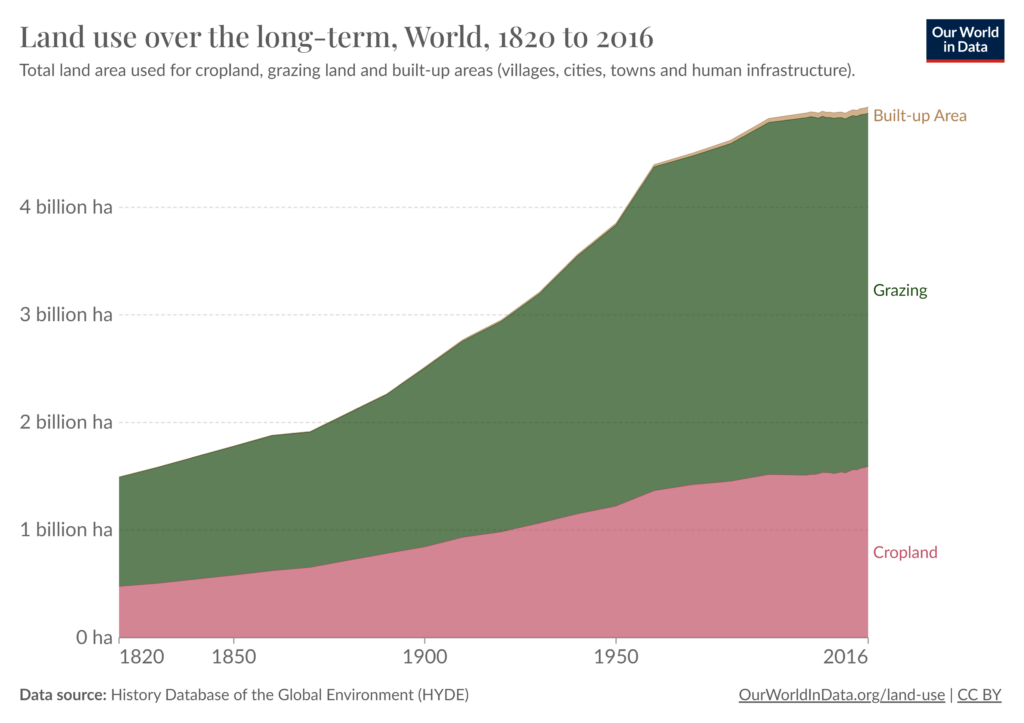
Figure 84: Land Used for Crops, Grazing, and Habitations. Source: Our World in Data, article by Hannah Ritchie and Max Roser. WW201
There were roughly 1 billion humans on the planet in 1820 and 7.5 billion in 2016, a factor of 7.5 times, so the increase in agricultural land use of only 3.3 times is a testament to the incredible productivity increases of mechanized agriculture and the “green revolution”. Not only were agricultural productivity increases able to feed the world on less land per person, but we have largely eliminated the cyclical starvation that used to exist in some regions.
Given that, would it really be a big deal to feed an extra 25% more of us in 2050? In order to answer that question, we have to look at agricultural land use a bit more closely.
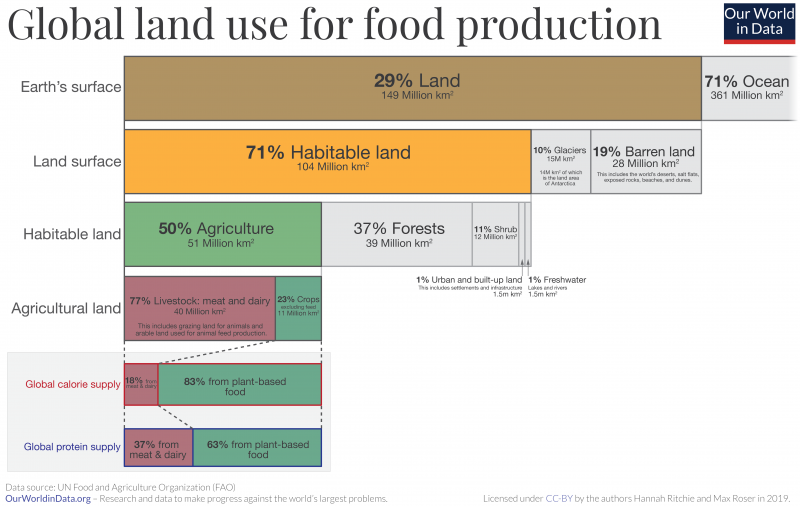
Figure 85: Land Used for Food Production. Source: Our World in Data, article by Hannah Ritchie and Max Roser. WW202
If diets and agricultural productivity were to stay the same, an extra 2 billion people would require that 63% of habitable land be devoted to agriculture, up from about 25% in 1900[2].
But diets will not stay the same. As countries get richer, people buy more meat, and, as the graphic shows, most of the world’s calories come from crops but three quarters of the agricultural land is used for livestock production, either for grazing directly or for crops grown to feed animals. In the US, a lot of corn is grown to feed cows and in China a lot of soybeans to feed pigs. Growing meat is inefficient in that a lot more food energy goes in than comes out. The table below shows this inefficiency by type of meat. Chickens, for example, turn 11% of the calories in their feed into calories in the meat that is eaten, and only 20% of the protein in their feed into meat protein. Clearly cows are considerably more inefficient.
Table 22: Meat growth inefficiencies. The last column shows how much of a weight of feed is converted into a weight of edible meat. The first two columns have similar statistics for the conversion of inputs into outputs but account also for losses due to waste and spoilage. Source: https://awellfedworld.org/feed-ratios/
| Calories in feed to calories in meat % | Protein in feed to protein in meat % | Feed Conversion (feed weight to meat edible weight) % | |
| Poultry | 11% | 20% | 22% |
| Pigs | 10% | 15% | 11% |
| Cows | 1% | 4% | 4% |
If everyone in the world ate meat like an American (125 kg = 275 lb. per year, a lot of it beef) or a Brazilian (97 kg) or even an Italian (69 kg) we would need more than 100% of all habitable land on earth to provide for the required pasture and feed crops. Conversely if everyone on earth ate like a Chinese (61 kg, but mostly pork), an Algerian (19 kg), or an Indian (4.5 kg) we would need less land than currently farmed. Clearly an increasing worldwide demand for meat, beef in particular, will push up the amount of agricultural land required even in the absence of further population growth.
How much is the demand for meat likely to grow? In the charts below, we can see that world per capita consumption of meat has increased steadily as people’s incomes have increased and the relative price of meat has fallen. Chinese consumption of meat, primarily pigs, rose sharply but has recently leveled off, as has overall consumption of meat in the US. In France meat consumption has declined over the past two decades. We can also see that consumption of poultry, the most efficient of meats, has been relatively increasing.
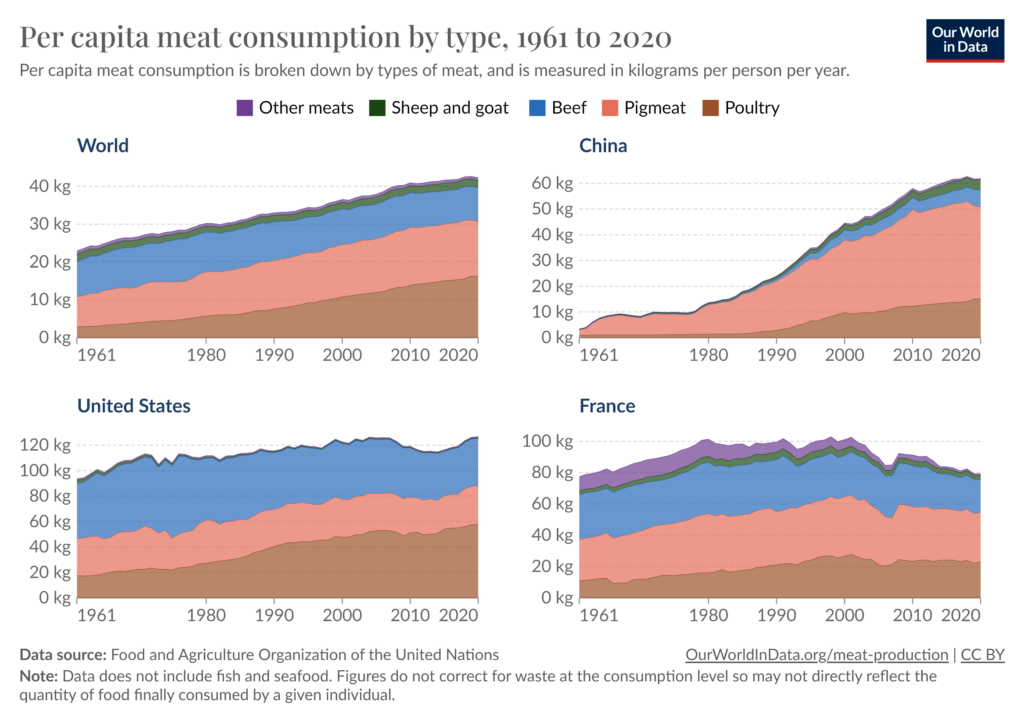
Figure 86: Per Capita Meat Consumption. Graphic Source: Our World in Data https://ourworldindata.org/meat-production . WW203
In an article entitled “Are We Approaching Peak Meat?” the authors find that meat consumption grows with GDP per capita until a certain level is reached, after which there is no correlation between these measures[3]. The GDP per capita they report is $40,000 (2019 dollars) which would imply a pretty large increase in demand for meat, but the graphs above show that there is a lot of variability between countries. Demand in China seems to be leveling off despite a still growing GDP per capita of $12,000, and in France, meat consumption is declining even though people only eat about half as much meat as we do in the US. Even in the US, chicken consumption has increased relative to beef, and it takes less feed to grow the same weight of chicken. So, meat consumption depends on a lot of factors including culture, price, and distribution of income. All we can say is that given past trends, demand for meat will continue to increase in developing countries leading to an overall increase in demand worldwide, and that demand is likely to be substantial. Given the inefficiency of meat production relative to primary crops, this will drive the need for additional agricultural output, which in turn will lead to more land cultivation unless agricultural productivity can grow fast enough to keep up.
Before we look at whether agricultural productivity can keep up, let’s look briefly at the situation in some specific countries. The US is blessed with a lot of highly productive agricultural land compared to its population. In fact, the US has 1.21 hectares (3 acres) of agricultural land in use per person, while China has .37 hectares (.91 acre) and India .13 hectares (.32 acre)[4]. With 3 times as much agricultural land per person as China, and 10 times as much as India, the US can support current levels of consumption. So, where’s the beef, so to speak? Agriculture, like oil, is traded worldwide. The US is a huge exporter of agricultural products including dairy products and meats as well as soybeans for animal feed, but perhaps surprisingly, our exports of agricultural products at $177 billion in 2021 were almost exactly balanced by our imports of agricultural products at $171 billion[5]. Even in Sub-Saharan Africa, agricultural imports and exports are almost balanced, with the difference due to countries rich in resources such as oil[6]. The point is that agriculture is truly a worldwide business and has to be thought of that way. Less grain fed to livestock anywhere in the world makes land available for more efficient crops which reduces the total demand for agricultural land. Since overall, the bulk of agricultural land is used to produce meat, eating less meat would reduce the amount of new farmland required to feed an increased population, or could even reduce current usage.
But of course, we’re not going to repeal the laws of supply and demand, and as people get richer, they will want more meat, although maybe less cow and more pig and chicken. Can that be accomplished without expanding the amount of farmland? In particular, can we produce more of what people want using the same amount of land?
While the increase in agricultural productivity has been dramatic over the last half century, both in crop and in meat production (think factory farming), further increases in productivity are likely to be slower as countries reach the productivity frontier. Worldwide agricultural total factor productivity growth[7] slowed to 1.14 percent per year in the decade from 2011 to 2021, which is well below the 1.9 percent growth rate required to sustainably grow agricultural output to meet population growth, according to the Virginia Tech 2023 Global Agricultural Productivity (GAP) Report[8]. The chart below from that report shows that these productivity gains were not evenly distributed. As we have noted before, most of the growth in output in Sub-Saharan Africa was due to increasing land under cultivation, while in South Asia and China almost all the growth was from increased productivity. In the United States, productivity growth was stagnant, almost all the increase in output was explained by increasing inputs such as fertilizer. While crops differ, US agriculture is probably close to the productivity frontier and this suggests that that new growth in agricultural productivity follows the expected curve of fast at first, and slower later, as countries adopt best practices, scale, and use of capital. Looking at the chart also makes it clear that the growth of land under cultivation in Africa is unsustainable. We looked at some of the reasons for this trend in the section on agricultural productivity and concluded that economic development will be key to both slowing population growth in Africa and in increasing per-capita GDP. With growth in GDP and non-farm employment will come investments required to boost agricultural productivity, including infrastructure investments to help get products to market and reduce waste.
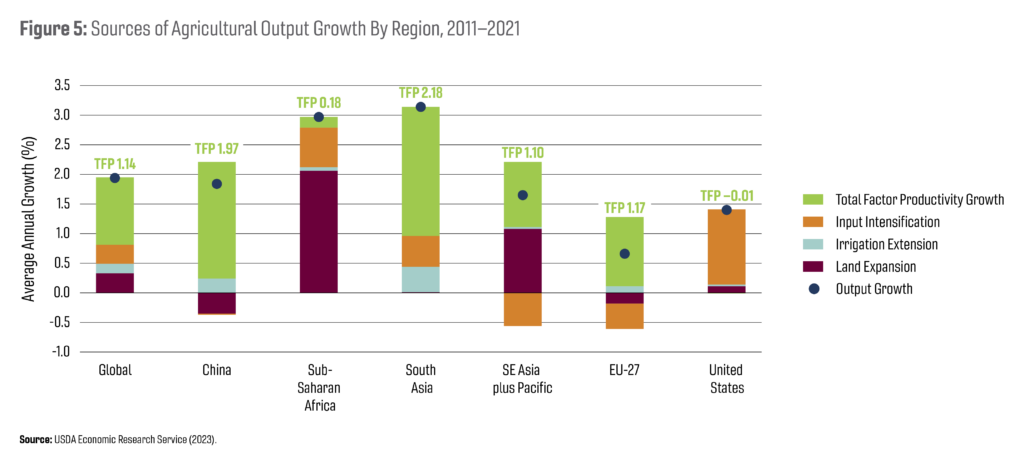
Figure 87: Sources of agricultural output growth by region. Source: Virginia Tech 2023 Global Agricultural Productivity (GAP) Report based on US Department of Agriculture Economics Research Service data. Used with permission. WW204
Clearly productivity gains can help reduce the amount of added agricultural land required to meet demand. Anything that can be done to help that along, especially in Africa, would be good. But it seems highly unlikely that productivity gains by themselves will be sufficient to meet the demand of 10 billion people with more disposable income.
Up to now, we haven’t made the connection between climate change and land use, but the two are intimately related. Deforestation, and methane emissions from raising livestock, are drivers of the greenhouse gas emissions from agriculture, which we saw was one of the major sources outside the energy sector. Chopping down the Amazon to raise cattle is not good for climate change. The methods we discussed for reducing greenhouse gas emissions apply to both of these agricultural sources. Reducing deforestation in the interest of climate change would also address its conversion to farmland, and requiring methane capture from raising livestock would raise the price of meat considerably, which would reduce demand. Meat could of course be taxed directly in proportion to its effect on both climate change and land use, although that is unlikely given political realities. For some time now there has been declining demand for meat in some countries and a switch from beef to chicken in others, so cultural and health effects may help keep growth down. Finally, in addition to plant-based meat substitutes, work is progressing on cultured meats. In theory the latter could be more efficiently grown than meat on the hoof.
The flip side of agriculture’s impact on climate change is climate change’s impact on agriculture. NASA used the output of climate models as input to state-of-the-art global crop models to predict what would happen if greenhouse gas emissions stayed on current track. These predictions, specifically focused on corn and wheat, found that maize (corn) crop yields would decline 24%, while wheat could potentially see growth of about 17%[9]. Other studies find mostly reductions in yields from climate change including to rice crops in Asia[10]. In short, climate change may make it more difficult to feed the world and increase variability in output from year to year.
Extinction is Forever
There have been five mass extinction events in earth’s history in which 75% or more of species were eradicated. Human-lead habitat destruction and climate change so far are not anywhere in that ballpark. We haven’t yet competed with the asteroid that ended the dinosaurs with the sudden impact of 10 billion Hiroshima sized atomic bombs[11]. None-the-less current extinction rates are between 1000-10,000 times higher than the “background” extinction rate seen before modern times[12]. Besides extinctions, there are widespread reductions in animal populations as would be expected from habitat reduction. The International Union for Conservation of Nature (IUCN) has undertaken the enormous task of analyzing the populations of 150,000 species and finds that 42,100 (28%) of them are threatened with extinction. That includes 41% of the amphibians, 27% of the mammals, 34% of the conifers, 36% of the corals, and 13% of the birds, among others[13]. Other scientists analyzing this data calculate that many other species not on the threatened species list are also showing population declines that precede extinction. They point out that 48% of the covered species are declining in population from habitat loss, fragmentation and degradation, the widespread use of pesticides, herbicides and other chemicals, overexploitation and hunting, and the effects of invasive species, aggravated by runaway climate change[14]. Clearly cutting down forests for agriculture is not going to help this situation, especially in the tropics where many of these species live.
Here is the population story for African elephants. Turns out there is a forest species and a grasslands species, both threatened, the former critically, by habitat loss and poaching for ivory.
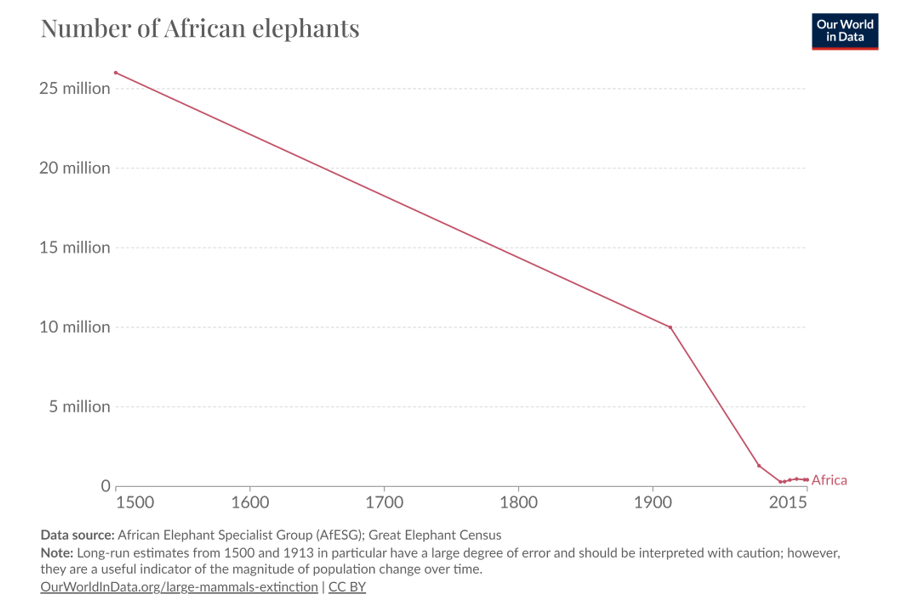
Figure 88: Number of African Elephants. Graphic Source: Our World in Data. WW205
There are about 415,000 African elephants left in the world and their population is still declining. Compare that to 8,000,000,000 humans.
We should leave a little room on the earth for our fellow inhabitants.
Other Sustainability Issues
Climate change and land use are the two heavy lifts of sustainability that we have to solve. With such a large human population, though, we have to treat almost everything we extract from nature sustainably. After all, it turned out that the atmosphere was limited, at least in its capacity to absorb our waste. We won’t discuss other sustainability issues other than to mention them, but they include managing water where that is a scarce resource, such as in the US Southwest and Sub-Saharan Africa; fisheries so that the 200 million tons of food we extract from the seas doesn’t cause the commercial extinction of species; and certain minerals such as phosphorus which is an essential ingredient of fertilizer. Concrete is made with sand which, believe it or not, is a finite resource. Estimates say we could run out of construction grade sand by 2020[15]. While we’ve looked briefly at agricultural land requirements, we haven’t looked at what is needed for agriculture to be sustainable. There are many other physical world sustainability issues, such as the impact of plastics on the environment and the illegal trade in wild animals.
Like climate change, all of these issues require regional or global cooperation. It really is one world, dominated by humans.
[1] Hannah Ritchie and Max Roser (2013) – “Land Use”. Published online at OurWorldInData.org. Retrieved from: ‘https://ourworldindata.org/land-use’ [Online Resource]
[2] https://ourworldindata.org/land-use#:~:text=Over%20the%20last%20few%20centuries,area%20was%20used%20for%20farming.
[3] Whitton, Clare, Diana Bogueva, Dora Marinova, and Clive J. C. Phillips. 2021. “Are We Approaching Peak Meat Consumption? Analysis of Meat Consumption from 2000 to 2019 in 35 Countries and Its Relationship to Gross Domestic Product.” Animals: An Open Access Journal from MDPI 11 (12). https://doi.org/10.3390/ani11123466. I think further multivariate analysis is called for.
[4] https://www.brookings.edu/articles/unpacking-the-misconceptions-about-africas-food-imports/#:~:text=SSA’s%20top%20exports%20are%20mainly,oilseeds%2C%20and%20frozen%20meat%20products.https://ourworldindata.org/grapher/agricultural-area-per-capita?country=OWID_WRL~OWID_NAM~OWID_SAM~OWID_AFR~OWID_EUR~OWID_ASI~USA~CHN~IND
[5] https://www.ers.usda.gov/data-products/ag-and-food-statistics-charting-the-essentials/agricultural-trade/#:~:text=Total%20U.S.%20agricultural%20trade%20rose,in%202021%20to%20%24171%20billion.
[7] Total factor productivity (TFP) is growth in output not due to increasing inputs such as land.
[8] https://globalagriculturalproductivity.org/wp-content/uploads/2023/10/2023-GAP_Executive-Summary_FINAL.pdf Agnew, J. & Hendery, S. (2023). 2023 Global Agricultural Productivity Report: Every Farmer, Every Tool. Virginia Tech College of Agriculture and Life Sciences. The report is based on USDA Research Service data.
[9] https://climate.nasa.gov/news/3124/global-climate-change-impact-on-crops-expected-within-10-years-nasa-study-finds/
[10] https://www.frontiersin.org/articles/10.3389/fpls.2022.925548/full
[11] https://abcnews.go.com/US/asteroid-wiped-dinosaurs-powerful-10-billion-atomic-bombs/story?id=65537028#:~:text=Scientists%20have%20found%20hard%20evidence,atomic%20bombs%20of%20the%20same
[12] https://www.forbes.com/sites/grrlscientist/2023/07/19/modern-sixth-mass-extinction-event-will-be-worse-than-first-predicted/?sh=2b3fe2ad4ab6
[13] https://www.iucnredlist.org/ Interesting to note that the birds are doing relatively better. They are the only dinosaur descendants to survive the Yucatan asteroid. Something to be said for mobility and feathers.
[14] https://onlinelibrary.wiley.com/doi/10.1111/brv.12974
[15] Scientific American, February 2024, p 62
[RF1]Need to mention the use of biofuels. See https://www.iea.org/articles/what-does-net-zero-emissions-by-2050-mean-for-bioenergy-and-land-use
